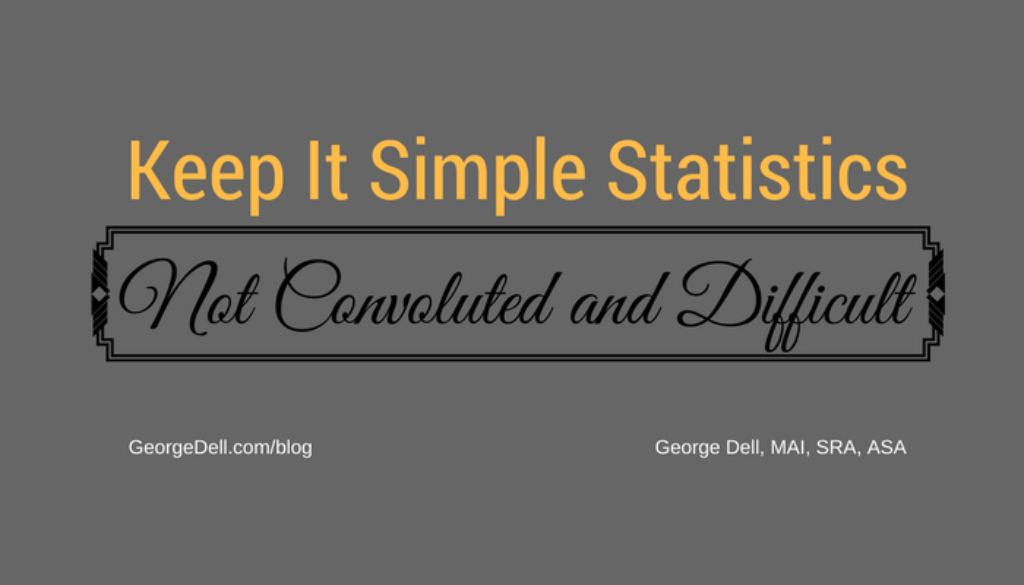Sez the “anti-statistics” guy!
Statistics has been touted as an appraisal tool for a while. For many years, while heavily involved in the Appraisal Institute, I became a statistical evangelist and people would run from me. I’d come to believe that there was a gap in appraiser education. I presented a (relatively unnoticed) paper for the ARES conference in 2004 entitled “The Appraiser Education Chasm,” believing the gap continued to grow.
My education while in graduate-level econometrics classes at SDSU and UCSD, made clear that a chasm existed and was growing. It was the chasm between what statistics formerly emphasized, and where the world was heading. Statistics addressed two types of problems: a) describing a population of interest from limited data; and, b) predicting/estimating a value of a hypothetical data point. (We call this “the subject”.)
To make that story short, it was change in technology causing two dramatic shifts:
- Most ‘statistical’ problems no longer required characterizing or describing a large population. The world changed from sparse, subjectively measured data to complete or near complete data sets. Often these were available electronically. The challenge grew to what we know today as “big data.” The problem became the opposite – helping the human brain understand the sea of data.
- Computer power enabled the computation of large data sets. Computation power also enabled quick summary statistics and plots of data, to visualize and ‘see’ the data. The bywords of the movement was “let the data speak.”
Inferential statistics became unnecessary for most problems. As you might remember from your middle school class, you used a random sample from the population in which you have an interest. Inferential statistics told you how well the random sample represented the population. But when you can simply look at all the data, there is no need to use statistical sampling.
Another issue came up.
The appraisal problem (as historically taught) never involved describing a population by drawing a random sample.
As The Appraisal of Real Estate says: “Predictive models are predominant in most valuation settings.” Yet I watched helplessly the growth of inferential statistics as an ‘advanced’ quantitative pseudo-science for appraisal work. Much of my litigation practice concerns this topic. Yet the principles are simple. For inferential statistics to be validly applied:
- The problem requires that a population be described.
- The complete data set must not be available, or too expensive to gather.
- A random sample (or random assignment) is required.
The Good News
The proliferation of this major digression of appraisal education may be coming to a stop. But it will not come internally. It comes from the ASA – The American Statistical Association itself. For the first time in its history, the ASA released a position statement. It is on “Statistical Significance and P-values” and its wide misuse as a substitute for “appropriately chosen techniques, properly conducted analyses, and correct interpretation.”
This may explain why we do not teach the convoluted and difficult inferential statistics in my Stats, Graphs, and Data Science classes. It’s of little or no use for appraisers!
Keep It Simple Statistics!

August 16, 2017 @ 10:31 pm
Always enjoy your posts George. Thank you.
August 21, 2017 @ 8:33 am
Your statement “the chasm between what statistics formerly emphasized, and where the world was heading” is clearly reflected by the older statistical texts in my possession. They all begin with the division of statistics study into the two groups of inference and prediction, but it’s inference that takes centre stage, with prediction relegated to the footnotes or addendum. The distinction between the two objectives is soon forgotten by the student. Prediction is front and centre with the recent texts, but interestingly these books have titles where the word statistics is absent, replaced with labels like modelling, data science, and machine learning, possibly at the insistence of the publishers.
Market Target? - George Dell, SRA, MAI, ASA, CRE
February 1, 2023 @ 1:17 am
[…] problem, again, is words. Does “market” mean the marketplace? The possible buyers/sellers? Their transactions? […]